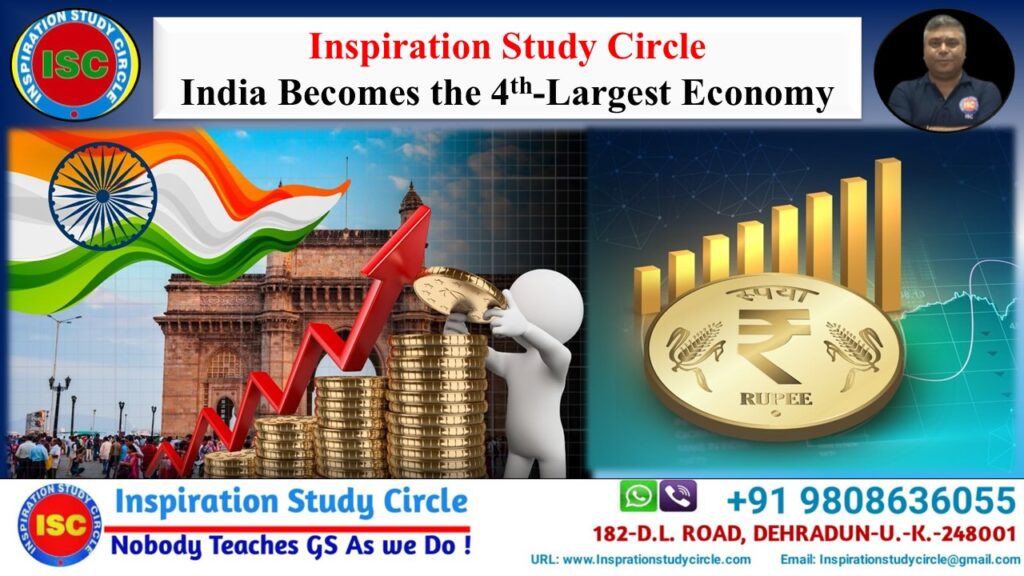
UPSC Mains 2025 Analysis and Overview
UPSC Mains 2025 Analysis and Overview Table of Contents The UPSC Mains 2025 analysis indicated a paper that was a balance of static and analytical questions,

On 24th May, 2025, NITI Aayog CEO B.V.R. Subrahmanyam announced that, according to IMF data, India has surpassed Japan to become the fourth-largest economy globally.
Indian Economy 2025: According to the April 2025 edition of the IMF’s World Economic Outlook, India’s economy is expected to grow by 6.2 per cent in 2025 and 6.3 per cent in 2026.
Following the 10th Governing Council meeting of NITI Aayog, Mr. Subrahmanyam informed reporters that the current geopolitical and economic climate is favorable for India. “As of now, we are the fourth largest economy and a USD 4 trillion economy,” he stated.
According to the IMF, India’s GDP is currently $4.187 trillion, overtaking Japan’s $4.186 trillion.
Citing IMF data, Subrahmanyam said that the Indian Economy, today, is larger than Japan.
India is now behind only three countries in terms of GDP size: the USA ($30.51 trillion), China ($19.23 trillion), and Germany ($4.74 trillion). The UK is in the fifth position now with a GDP of $3.38 trillion.
USA’s GDP is 7 times that of India’s as of now.
According to the April 2025 edition of the IMF’s World Economic Outlook, India’s economy is expected to grow by 6.2 per cent in 2025 and 6.3 per cent in 2026, maintaining a solid lead over global and regional peers.
The April 2025 edition of the WEO shows a downward revision in the 2025 forecast compared to the January 2025 update, reflecting the impact of heightened global trade tensions and growing uncertainty.
Despite India’s progress in terms of GDP size (nominal), its per capita ranking is abysmal at 144th globally in the world. According to the IMF, it is $2,850-2,900, which is far less than some of the smaller countries.
The top three countries in terms of per capita income are Luxembourg ($141,080), Switzerland ($111,716), and Ireland ($107,243).
In the group of emerging market and developing economies, China will witness a particularly sharp decline in its GDP growth over 2025–50—a deceleration of 2.7 percentage points relative to the 2016–18 average—reflecting acutely adverse demographics, as well as the approaching end of the era of rapid catch-up to frontier productivity, stated IMF In April 2025 Report.
India, with its relatively favorable near-term demographics, is projected to experience a smaller growth decline in 2025–50 (of about 0.7 percentage point), but the decline will intensify over 2050–2100 as the country passes its demographic turning point. Low-income countries are also expected to see a sharper deceleration in growth in the second half of the century, once demographic dividends turn into headwinds.
The economy of India is a developing mixed economy with a notable public sector in strategic sectors. It is the world’s fourth-largest economy by nominal GDP and the third-largest by purchasing power parity (PPP); on a per capita income basis, India ranked 136th by GDP (nominal) and 119th by GDP (PPP).
From independence in 1947 until 1991, successive governments followed the Soviet model and promoted protectionist economic policies, with extensive Sovietization, state intervention, demand-side economics, natural resources, bureaucrat-driven enterprises, and economic regulation. This is characterised as dirigisme, in the form of the Licence Raj.
The end of the Cold War and an acute balance of payments crisis in 1991 led to the adoption of a broad economic liberalisation in India and indicative planning.
India has about 1,900 public sector companies, with the Indian state having complete control and ownership of railways and highways. The Indian government has major control over banking, insurance, farming, fertilizers and chemicals, airports, and essential utilities. The state also exerts substantial control over digitalization, telecommunication, supercomputing, space, port, and shipping industries, which were effectively nationalised in the mid-1950s but have seen the emergence of key corporate players.
Nearly 70% of India’s GDP is driven by domestic consumption; the country remains the world’s fourth-largest consumer market. Aside from private consumption, India’s GDP is also fueled by government spending, investments, and exports.
Economists and social scientists often consider India a welfare state. India’s overall social welfare spending stood at 8.6% of GDP in 2021-22, which is much lower than the average for OECD nations.
Corruption has been a pervasive problem in India. A 2005 study by Transparency International (TI) found that more than half of those surveyed had first-hand experience of paying a bribe or peddling influence to get a job done in a public office in the previous year.
In 1996, red tape, bureaucracy, and the Licence Raj were suggested as a cause for the institutionalised corruption and inefficiency.
More recent reports suggest the causes of corruption include excessive regulations and approval requirements, mandated spending programs, monopoly of certain goods and service providers by government-controlled institutions, bureaucracy with discretionary powers, and lack of transparent laws and processes.
In 2011, the Indian government concluded that most spending fails to reach its intended recipients, as the large and inefficient bureaucracy consumes budgets.
A Step was taken by Prime Minister Modi, on 8 November 2016, involved the demonetization of all 500 and 1000 rupee bank notes (replaced by new 500 and 2000 rupee notes) to return black money into the economy followed by criticism that the measure was deemed ineffective by economists and negatively affected the poorest people of India. This demonetisation, together with the introduction of the Goods and Services Tax (GST), is believed to be responsible for the slowdown in growth.
Climate Change: a major area of focus by RBI
Several banks, including State Bank of India, Axis Bank, ICICI Bank, and HDFC Bank, have taken the lead in funding green projects even as the Reserve Bank of India comes up with norms for lenders to disclose their actions on climate risk. RBI, in an earlier report in 2022, had said that climate change would require “intensive capital mobilisation” for which India needs $17.77 trillion.
The RBI recommends that regulated entities rely upon the Task Force on Climate-related Financial Disclosures (TCFD) framework, the most prominent climate disclosure framework globally, at least at the initial stage.
The economic growth in India has been driven by the expansion of the services, which have been growing consistently faster than other sectors. It is argued that the pattern of Indian development has been a specific one and that the country may be able to skip the intermediate industrialisation-led phase in the transformation of its economic structure. Serious concerns have been raised about the jobless nature of the economic growth.
Favourable macroeconomic performance has been a necessary but not sufficient condition for the significant improvement in the human development indicators. Although the rate of poverty declined after the economic reforms of 1991, the improvement in human development has been less than satisfactory. For instance, child malnutrition has continued to persist.
The World Bank suggests that the most important priorities are public sector reform, infrastructure, agricultural and rural development, removal of labour regulations, reforms in lagging states, and HIV/AIDS.
Prior to India’s Independence, from the period of 1900 to 1947, per capita income in India had either declined or stagnated. Post-Independence, Jawaharlal Nehru demonstrated his willingness to compromise socialism for the perceived benefit of the country to provide financial incentives for the expansion of private enterprise.
However, after the crisis of 1957, India turned towards import substitution industrialization and introduced foreign exchange.
The Nehru-Mahalanobis approach, often referred to as the Second Five-Year Plan, emphasized the development of basic and heavy industries as a means of accelerating economic growth. These included steel, copper, petrochemicals, paper, coal, and oil.
Mahalanobis strived for India to reach autonomy, ridding any outstanding debts. Critics disagreed with this approach, stating that the World Bank’s claim of Indian export prospects being low was falsified, and due to India’s inward-looking strategy, the growth opportunity of the world economy was missed.
The Indian economy is poised to remain the fastest-growing major economy in 2025-26, driven by its sound macroeconomic fundamentals, robust financial sector, and commitment towards sustainable growth, the Reserve Bank of India said in its annual report for 2024-25.
It, however, said that uncertainty about global trade post-protectionist measures, protracted geopolitical tensions, and global financial market volatility pose downside risks to the growth outlook and upside risks to the inflation outlook.
For 2025-26, the Reserve Bank of India has projected real gross domestic product (GDP) growth at 6.5 per cent and consumer price index (CPI) inflation at 4 per cent.
The report said that with inflation falling below the target in February and March 2025, supported by a sharp fall in food inflation, there is now greater confidence about a durable alignment of headline inflation with the target of 4 per cent over a 12-month horizon.
Prolonged geopolitical uncertainties, excessive global financial market volatilities, trade fragmentation, and restrictive trade policies pose upward risks to the inflation trajectory, it said.
On financial markets, the report said that during 2025-26, markets will closely track the implications of tariff policies of the US and reciprocal measures by others, as an uncertain policy environment may instill volatility in global financial markets.
Following a correction in the second half of 2024, Indian equity markets are expected to remain resilient amidst stable macroeconomic conditions and moderation in equity market valuations, although geopolitical uncertainty poses downside risk.
Disclaimer: The Above information is taken from the following sources: News 18 news network, Wikipedia, and the Indian Express.

UPSC Mains 2025 Analysis and Overview Table of Contents The UPSC Mains 2025 analysis indicated a paper that was a balance of static and analytical questions,

Last Minute Preparation Tips for UP PCS Prelims 2025 Table of Contents The Uttar Pradesh Public Service Commission conducts a series of annual examinations for

Explained: Next-Gen GST Overhaul and Reforms Table of Contents The GST Council in its 56th meeting on 3rd September, 2025, made the recommendations relating to changes in

Explained: Vikram-32 Chip Table of Contents Union Information and Broadcasting Minister Ashwini Vaishnaw recently unveiled India’s first indigenously developed 32-bit processor called VIKRAM-32. The minister presented the

UPSC Prelims 2026 Test Series Table of Contents Inspiration Study CircleUPSC Prelims 2026 Test Series The Union Public Service Commission (UPSC) is set to conduct

UPPSC- PCS 2025 Prelims Test Series UPPSC 2025 प्रारंभिक परीक्षा टेस्ट सीरीज़ उत्तर प्रदेश लोक सिविल सेवा 12 अक्टूबर 2025 को अपनी उच्च और संयुक्त